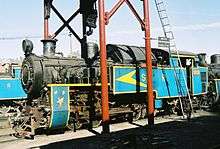Nilgiri Mountain Railway X class
| Nilgiri Mountain Railway X class | |||||||||||||||||||||||
|---|---|---|---|---|---|---|---|---|---|---|---|---|---|---|---|---|---|---|---|---|---|---|---|
 Nilgiri Mountain Railway locomotive No.37385 preserved in the Delhi Railway Museum. | |||||||||||||||||||||||
| |||||||||||||||||||||||
| |||||||||||||||||||||||
| |||||||||||||||||||||||
X class locomotives are metre gauge 0-8-2T rack and pinion compound locomotives working on the Nilgiri Mountain Railway in the Nilgiri Hills of southern India. They are used on the 20 kilometer section between Coonoor and Mettupalayam, where the gradient of the track can be as steep as 1 in 12.5. The railway uses the Abt system on these steep sections. X class locomotives are compound locomotives with two high-pressure and two low-pressure cylinders, located outside the locomotive's frames. The low-pressure cylinders drive the rack wheels and are positioned above the two main high-pressure cylinders which drive the main wheels.
This class of engines was acquired to replace the line's original Beyer-Peacock 2-4-0 engines, whose traction power was not enough to handle the traffic.[1][2] The X class locomotives were bought in two batches from the Swiss Locomotive and Machine Works, Winterthur, Switzerland. The first batch (12-nos.) started operating between 1920 and 1925, and the second batch (5-nos.) in 1952.[1][3]
SLM orders
| SLM Works Nos. | Year | Quantity | NMR No. | All India No. | Notes |
|---|---|---|---|---|---|
| 2456–2459, 2469–2470 | 1914 | 6 | 1–6 | 37384 | ex-No. 1 |
| 2734–2736, 2733 | 1920 | 4 | 7–10 | 37385–37388 | |
| 3000–3001 | 1925 | 2 | 11–12 | 37389–37390 | |
| 4069–4073 | 1952 | 5 | 13–17 | 37391–37395 | |
| unknown | 2011 - 2014 | 4 | 18-21 | 37396-37399 | Non-SLM |
Conversion to oil

Coil-fired Locomotive No. 37395 was modified to oil-fired in 2002. Soon after, another locomotive was modified the same way. The Railway aims to furnish more locomotives with the oil-firing system, since they are less likely to start forest fires caused by sparks. They are also easier to load with fuel. Only one fireman needs to travel with the driver of oil-fired locomotives, while coal-fired engines need two.[6][7]
New builds
To ease the load on the existing X class locomotives, four new oil-fired steam locomotives of X Class 0-8-2T rack and pinion compound engine bearing road were ordered, having a very similar design. The first one (No. X 37396) arrived in February 2011, entering service on March 24, 2011. The second one (No. X 37397) was rolled out at Golden Rock in February 2012 and entered service on NMR in March 2012. The third one built by Golden Rock, Trichy (No. X 37398) entered service in March 2013. The last one (No. X 37399) was rolled out on March 5, 2014, at the Central Workshop, Ponmalai, Tiruchirapalli to join the fleet after trials on the rack railway.
In fiction
In the 2016 animated film Thomas & Friends: The Great Race, a character named Ashima was based on the Nilgiri Mountain Railway X Class.[8][9] [Tina Desai]], an Indian actress and model, gave voice to the character.[10]
References
- 1 2 Bhandari, R. R. (2008). "Steam in history". IRFCA. Retrieved 2 March 2010.
- ↑ "Blue Mountain Railway". India for Visitors. indiaforvisitors.com. 2003. Retrieved 2 March 2010.
- ↑ "National Railway Museum". Rail in India. Retrieved 2 March 2010.
- ↑ Hughes 1992, p. 98
- ↑ Hughes 1996, p. 58
- ↑ Rajaram, R. (21 December 2009). "Work for manufacturing four new oil-fired steam locos begins". The Hindu. Chennai, India: The Hindu Group. Archived from the original on 31 December 2009.
- ↑ "Oil fired Steam engine on Nilagiri Railway , India". Encyclopedia.com. HighBeam. 2009. Retrieved 2 March 2010.
- ↑ "Meet Ashima, and Her Impact on Child Product Sales to India". India Briefing. March 31, 2016. Archived from the original on December 7, 2016. Retrieved July 13, 2017.
- ↑ "Ashima - Character Profile & Bio". Thomas & Friends - Official Website. Retrieved August 26, 2017.
- ↑ "Flying Scotsman on track to star in new 'more diverse' Thomas the Tank Engine film". ITV News. April 6, 2016. Archived from the original on August 11, 2016. Retrieved July 13, 2017.
External links
| Wikimedia Commons has media related to Nilgiri Mountain Railway class X. |
- Hughes, Hugh (1992). Indian Locomotives, Part 2 – Metre Gauge 1872–1940. Harrow, Middlesex: Continental Railway Circle. ISBN 0-9503469-9-3.
- Hughes, Hugh (1996). Indian Locomotives, Part 4 – 1941–1990. Harrow, Middlesex: Continental Railway Circle. ISBN 0-9521655-1-1.
- http://anno.onb.ac.at/cgi-content/anno-plus?aid=lok&datum=1926&psge=81&size=45